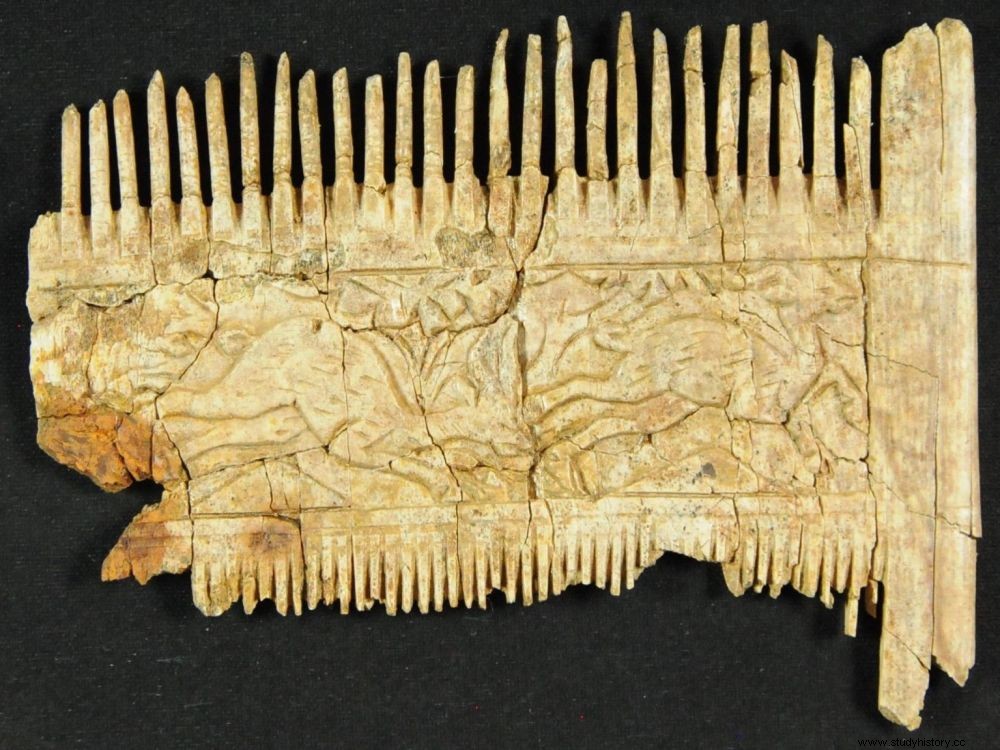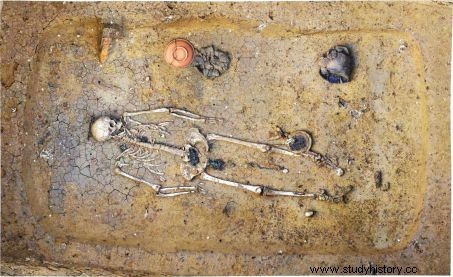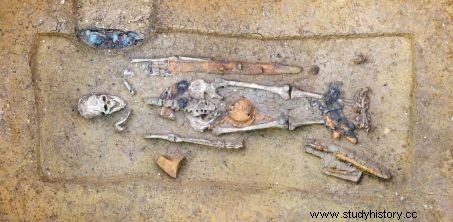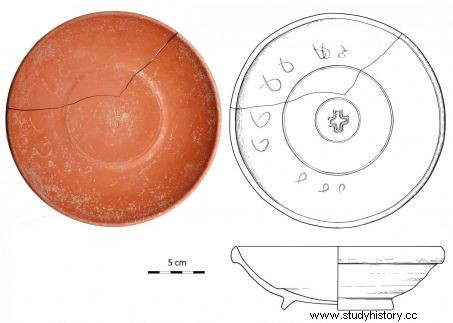In the Bavarian region of Swabia, archaeologists unearthed two tombs of members of the Germanic elite containing rare and luxurious objects:a carved ivory comb and an African sigillata ceramic bowl. These offerings, which are in themselves magnificent works of art, attest to the persistence, after the dissolution of the Roman Empire, of contacts with distant regions beyond the Alps and the Mediterranean.

Back of carved ivory comb found during excavations in Deiningen (Bavaria) in a tomb of the 6 th century.
Preventive excavations carried out in the summer of 2021 in the Bavarian village of Deiningen have proved surprisingly successful. Archaeologists from the Office for the Preservation of Bavarian Monuments (BLfD) expected to find burials, as the first discoveries at this site date from the 1930s. But they could not predict that the graves unearthed would contain surprising objects that would serve as clues while remaining enigmas. How could objects as rare and precious as a sculpted ivory comb and a ceramic bowl of Tunisian origin end up in this region 1500 years ago? And with whom were they buried? Archaeologists can only state hypotheses here, without resolving all the questions posed by their discoveries.
Exotic objects found in two tombs from the early Middle Ages
In recent months, 75 graves have been unearthed in the village of Deiningen, located in the Nördlinger Ries, in northern Swabia. Two of these tombs have particularly attracted the attention of archaeologists:they date from the 6th century and are richly furnished.
The first, that of a man aged 40 to 50, included weapons – a longsword, spear, shield, battle ax – but also a bronze basin and the remains of a bag containing a pair of scissors and an ivory comb. At his feet, remnants of spurs and bridles indicate that he could be the rider of the horse found in a pit near him.
In the second rests the body of a woman aged 30 to 40, with jewelry, food offerings (especially eggs) and a weaving sword, used to lift the threads in the loom. On its left, a pottery in the shape of a bowl stands out from the other containers found:it was not made in the region, but comes from a workshop located in present-day Tunisia, as indicated by the finesse of its craftsmanship. . This is an African clear sigillata ceramic (African red slip ), a type of pottery coated with a fine red glaze intended for table service, which was widely traded in the Mediterranean region in Roman times. The bowl found in very good condition at Deiningen is the first occurrence north of the Alps. Likewise for the ivory comb, as it is an extremely rare object in the 6th century.
Preventive excavations carried out in the summer of 2021 in the Bavarian village of Deiningen have proved surprisingly successful. Archaeologists from the Office for the Preservation of Bavarian Monuments (BLfD) expected to find burials, as the first discoveries at this site date from the 1930s. But they could not predict that the graves unearthed would contain surprising objects that would serve as clues while remaining enigmas. How could objects as rare and precious as a sculpted ivory comb and a ceramic bowl of Tunisian origin end up in this region 1500 years ago? And with whom were they buried? Archaeologists can only state hypotheses here, without resolving all the questions posed by their discoveries.
Exotic objects found in two tombs from the early Middle Ages
In recent months, 75 graves have been unearthed in the village of Deiningen, located in the Nördlinger Ries, in northern Swabia. Two of these burials have particularly attracted the attention of archaeologists:they date from the 6
th
century and are richly furnished.
The first, that of a man aged 40 to 50, included weapons – a longsword, spear, shield, battle ax – but also a bronze basin and the remains of a bag containing a pair of scissors and an ivory comb. At his feet, remnants of spurs and bridles indicate that he could be the rider of the horse found in a pit near him.
In the second rests the body of a woman aged 30 to 40, with jewelry, food offerings (especially eggs) and a weaving sword, used to lift the threads in the loom. On its left, a pottery in the shape of a bowl stands out from the other containers found:it was not made in the region, but comes from a workshop located in present-day Tunisia, as indicated by the finesse of its craftsmanship. . This is an African clear sigillata ceramic (African red slip ), a type of pottery coated with a fine red glaze intended for table service, which was widely traded in the Mediterranean region in Roman times. The bowl found in very good condition at Deiningen is the first occurrence north of the Alps. The same goes for the ivory comb, because it is an extremely rare object in the 6
e
century.

Burial of a woman at the Deiningen site . © Archäologiebüro Dr. Woidich / BLfD
A real work of art
The comb found is precious in many ways:it is as much an object of everyday life as an object of art, and therefore a sign of wealth. However, it is not uncommon to find combs as funerary objects in tombs dating from the High Middle Ages, archaeologists explain in a press release. But they are neither of this size, nor of this invoice, nor of this quality. After restoration, the ivory comb, originally found in several pieces, is 14 cm long and has delicate carvings depicting hunting scenes on both sides. Without being able to say with certainty, researchers think they see gazelles leaping to escape their predators. This is the first time that we find this kind of representations of exotic animals, and perhaps even African, on a comb dating from this period, because the combs usually found are all decorated with biblical and Christian motifs. There is an example of these so-called liturgical combs in the Louvre Museum in Paris; dating from the Carolingian period, it depicts "Samson tearing the lion".
An alaman rider attached to his appearance
The rarity of the comb is enough to indicate that its owner must have had high status. The fact that it is found in a man's grave takes on added significance, as the combs are most often found in female graves, although they also appear in male graves. We can therefore assume that this man had long hair and a beard, which he maintained with the scissors and the comb found in the toilet bag. This warrior buried for 1500 years therefore took care of his appearance, certainly with the aim of intimidating his opponents, but also to signify his status and his belonging to a civilized people.

Burial of a man at the Deiningen site . © Archäologiebüro Dr. Woidich / BLfD
A signature in the form of runes?
The sigillated ceramic bowl also raises questions because of the patterns it presents. As its name suggests (since the Latin sigillum means "seal"), sigillated ceramics often bear a stamp, which could be the cross that can be seen in its base, stamped from its manufacture. But how to interpret the writings engraved on the edge of the container? Are these inscriptions scribbles, one or more signatures, or symbols, ornamental or even magical? In this region which, at 6 e century, is within the Frankish Empire, people continued to write in Latin letters after the Roman domination, but runes were also used to inscribe formulas on objects, such as names or owners. Without being able to decipher them, the researchers wonder if these attempts at writing could be based on runes.

Signed ceramic bowl with inscriptions . © BLfD
Gifts or Loot Shares
For the archaeologists of the BLfD, these two objects must at the time not only have been "true luxury items ", but they show how much contact between distant regions, formerly provinces of the Roman Empire, was able to continue even after its dissolution.
In the 6th century, the region of Nördlinger Ries, formerly integrated into Raetia of the Roman Empire, was populated by the Alamanni, but it was certainly under the domination of the Franks, following the second victory of Clovis on this confederation of tribes Germanic. How did their owners acquire these items from exotic regions? A sovereign, of whom they would be eminent vassals, was able to offer them to them; they could also have received them as tribute or as part of the booty during a war campaign. We know that the Alemanni were involved in the conflicts between the Ostrogoths and the Eastern Roman Empire over the territory of present-day Italy.
Direct access to Italy
In Swabia, Alemannic remains have been unearthed since the 19
e
century and the municipality of Nordendorf, located a little further south of Deiningen, is an epicentre. The construction of a railway line in 1844 made it possible to find traces of an Alaman village dating from the 6
th
century, as well as a cemetery with nearly 450 tombs testifying to the occupation of the site by the Franks, the Alamanni and the Lombards. More recently, a double burial was discovered there in 2019 with similarities to those of Deiningen, since it is a rare equestrian burial and the grave of its rider including multiple weapons, harness and a service of so-called Coptic crockery (because probably made in Egypt, Asia Minor or other Mediterranean countries).
These burials indicate the existence in the region of a high-status group that maintained contacts with very distant regions and was able to acquire prestigious objects, either through trade or as a form of retribution and recognition of his power. It must be said that Nordendorf and Deiningen are only a few kilometers north of Augsburg, once the capital of Roman Raetia. This important commercial city was directly connected to the Po plain, in Italy, by the Via Claudia Augusta, a strategic axis which crossed the Alps and found its terminus at the limes of the Danube, in Bavaria.
